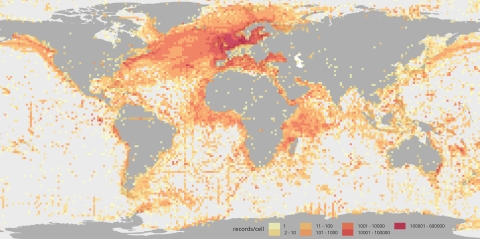European Ocean Biogeographic Information System (EurOBIS) celebrates its 15th anniversary
Established in 2004, EurOBIS aims at centralising and making available the largely scattered marine species biogeographic data in Europe. Today – 15 years later – it hosts no less than 24 million distribution records of 62.299 species. Thanks to EurOBIS and the effort of many scientists working on a voluntary basis, these valuable data have a second life.


Photo: Geographical distribution of the EurOBIS occurrence records. www.eurobis.org
EurOBIS (www.eurobis.org) was developed by the Flanders Marine Institute in 2004, within the framework of the MarBEF project (MARine Biodiversity and Ecosystem Functioning). It brings together biogeographic data collected within European marine waters, or by European researchers and institutes outside Europe. It focuses on taxonomy and distribution records in space and time and offers a number of online tools to easily query and visualise the data. Currently, EurOBIS holds 889 datasets, representing 62.299 species and 24 million distribution records.
With more than 6 million distribution records, fish are the most common in the database, followed by (sea) birds and marine mammals. At a species level, Atlantic herring, dab, whiting and Atlantic cod take the lead with 650-780.000 distribution records each, with some of them going back to the early 17th century, predating Linnaeus and Darwin. The oldest record is for a masked crab, registered in 1507 in UK waters and added to the EurOBIS database in May 2019.
Over the years, the EurOBIS database structure has evolved, making it possible to not only capture presence or abundance of species, but also e.g. biomass data and length measurements in a standardised and structured way. Remarkably, even ‘blubber thickness in marine mammals’ is part of the EurOBIS information system, with 247 measurements made on the beach, in species such as harbour porpoise, grey seal, harbour seal, white-beaked dolphin or bottlenose dolphin.
Similar to what happens with other regional nodes, EurOBIS data flow to the global initiative Ocean Biogeographic Information System (OBIS) and eventually become available via the Global Biodiversity Information Facility (GBIF), hosting global marine and terrestrial distribution data. From 2009 EurOBIS became the backbone of the European Marine Observation and Data Network Biology (EMODnet Biology), allowing a flow of EurOBIS data through its portal. In 2014 EurOBIS became part of the central Species Information Backbone of LifeWatch, which aims at standardizing species data and integrating the distributed biodiversity data and taxonomic repositories and operating facilities as well as filling the gaps in our knowledge. The EurOBIS data management team is supported by LifeWatch Belgium, part of the European LifeWatch E-Science Infrastructure for Biodiversity and Ecosystem Research.




